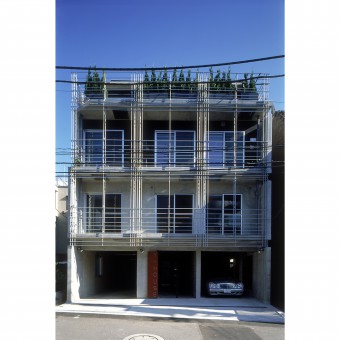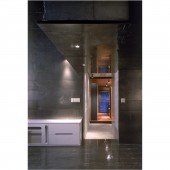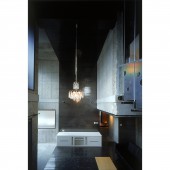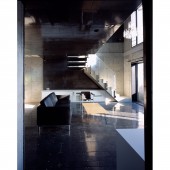Loop by Loop Private Apartment Building by ir Frank la Rivière |
Home > Winners > #61016 |
 |
|
||||
| DESIGN DETAILS | |||||
| DESIGN NAME: Loop by Loop PRIMARY FUNCTION: Private Apartment Building INSPIRATION: The the site with its unfinished building inspired the notion that the condition of its abandonment could generate new ideas and approaches as a result of the necessity to respond to the existing structure and would therefore be particularly different from a project conceived from scratch. This informed the strategy of erasing and inserting to achieve the client requirements in an architectural expressive way and making best use of the concrete shell, as an intermediary entity. UNIQUE PROPERTIES / PROJECT DESCRIPTION: An unfinished concrete shell was the starting point for this project. Put up for sale the site was purchased by our client with the idea to create a large apartment for private habitation for his family. The idea of this project was to treat the building as a neutral background for habitation. Finishes contrast with and wrap the concrete, erased where needed to allow for a loop to be inserted, as freestanding piece of furniture on which live takes centre stage. Each loop in its own material. OPERATION / FLOW / INTERACTION: The general architectonic idea of this project was to treat the existing unfinished building both as a sort of support for and as a neutral background for the new functions and spaces. Partial finishes contrast and wrap the rough concrete, only where needed for a precise adjustment to the requirements of the space. This act of wrapping partially given in by balancing the architectural intervention with the available budget results either in a horizontal loop or a vertical loop shape. All these interventions to the existing building are expressed as additions to the building leaving them somehow free from the existing concrete or added with minimal detailing just inserted in the concrete such as the handrails in the staircase. The other important aim of the design was to create spaces that are larger than the existing wall to wall distance by erasing part of the existing structure. In the liberated spaces the previously mentioned loops were inserted as large pieces of furniture. The result is a sort of islands between which daily life will evolve and they determine the living space, dining kitchen, the master bedroom and the children’s and guest bedrooms. PROJECT DURATION AND LOCATION: Design Period: August 2003 - May 2004 Construction Period: June 2004 - December 2004 FITS BEST INTO CATEGORY: Architecture, Building and Structure Design |
PRODUCTION / REALIZATION TECHNOLOGY: Each loop was given just one finish for the floor, walls and ceilings. To strengthen the experience of hopping between these islands and in order to create a different quality per space, each loop was given a different finish, such as bamboo (an environmentally friendly material that absorbs CO2 better than trees) for the dining kitchen, galvanised steel plate for the living, vulcanised paper made from recycled pulp for the guest room or cushioned denim fabric for the children’s bedroom. Colour was used in the same manner; one colour per space and in the form of a loop. Towards the exterior the 500 mm set-back from the façade of the loops, as a response to the structural necessity to leave some of the concrete for stability, creates a similar transition zone but now between interior and exterior. SPECIFICATIONS / TECHNICAL PROPERTIES: Foundation: Flat bed foundation, Piles Underground and above ground: Reinforced concrete structure Site Area 203.56 ㎡ Building Area 124.74㎡ Gross Floor Area 466.01 ㎡ Area Per Floor L4 Level 4: 66.23m2, balcony 52.93m2 L3 level 3: 117.23m, balcony 11.15m2 L2 level 2: 120.31m2, balcony 11.15m2 L1 level 1: 114.34m2 B1 basement level 1; 43.84m2, patio 8.70m2 Area Per Unit Unit A 201.98m2 Unit B 67.22m2 Unit C 101.51m2 Building Coverage Ratio 61.91% (depending on land-use zoning) Building Floor Area Ratio 167.66% Number of Floors 1basement level, 4 levels above ground Dimensions Max Height 12.100 m Max. Eaves height 11.700 m TAGS: House, apartment building, Tokyo, concrete, loop RESEARCH ABSTRACT: On a space planning level, the merit of retaining the building was evident. A larger volume of space would be available to the client than if the building would have been torn down and a new one family residence would have been constructed. The loss of space, if a stand alone private residence would have been constructed, would have been significant as there would not have been any beneficial reductions of the square meters communal spaces from the total allowable square meters. After checking the legal aspects of the project, we found that the authorities accepted the possibility of retaining the status of collective housing as initially planned, while allowing for a reduction of the number of apartments to 3 only. The condition of the authorities was that at least one apartment needed to be situated on the top floor. CHALLENGE: A problem posed by the idea of retaining the building was the fact that the structure had not been constructed after our specifications and that a risk of defects remained. This meant to us that the starting point of any design would be the question how to deal with the structure. The structure had both to be finished, because only 95% of the concrete was in place and it needed to be adapted. The approach we developed was to have the structural engineer immediately check in an early stage the structural viability of any alterations proposed and to check the strength of concrete by boring tests on site. On starting to give form to the client requirements we discussed in the very early stages the need to liberate space within this structure in order to create a better flow of space. The rather restrictive one room apartments with their one directional orientation and small wall to wall distances were not suited for the requirements of a large apartment. Also, if we could alter the walls by erasing strategically we could create unexpected spaces such as combining the double height spaces of two adjacent apartments to one large double height space. We could connect spaces in a direction perpendicular to their previously planned orientation and use the existing internal staircases to create an intricate network of interconnected spaces. Therefore, after I had sketched the very basic space planning the structural engineer set to work checking if this design would be possible by putting the whole structure in a special computer model that allows judging the load bearing capacity of the building as a whole. Only after the calculations showed that there was sufficient over-capacity in the wall structure we worked out the basic concept into further detail with the security that large parts of some walls could be removed. This potential for the creation of these interesting spaces was therefore justified on the basis of the structural calculations that put the work of the structural engineer in opposition to the normal constructive approach; here the concept was constructing through erasure. ADDED DATE: 2017-09-24 14:28:45 TEAM MEMBERS (4) : ir Frank la Rivière, Principal Designer/Architect, Supporting Architect: Yamashiro Satoru + Buildinglandscape Inc (Otake Takanori, permit application: Nishizawa Takao ), Strucutural Engineer: Jun Sato Structural Engineers (Sato Jun) and MEP Designer: Oguma Masaharu IMAGE CREDITS: Photographer: Shigeo Ogawa, image 1,2,3,4 Photographer: Ryota Atarashi, image 5 PATENTS/COPYRIGHTS: Copyrights belong to ir Frank la Rivière, FRA inc 2004 |
||||
| Visit the following page to learn more: http://www.frank-la-riviere.com | |||||
| AWARD DETAILS | |
 |
Loop by Loop Private Apartment Building by Ir Frank La Rivière is Winner in Architecture, Building and Structure Design Category, 2017 - 2018.· Read the interview with designer ir Frank la Rivière for design Loop by Loop here.· Press Members: Login or Register to request an exclusive interview with ir Frank la Rivière. · Click here to register inorder to view the profile and other works by ir Frank la Rivière. |
| SOCIAL |
| + Add to Likes / Favorites | Send to My Email | Comment | Testimonials | View Press-Release | Press Kit |
Did you like Ir Frank La Rivière's Architecture Design?
You will most likely enjoy other award winning architecture design as well.
Click here to view more Award Winning Architecture Design.








